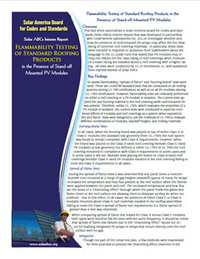
Fire Classification Rating Testing of Stand-Off Mounted Photovoltaic Module and Systems
Download the one-page Summary (PDF, 309KB) or the full report (PDF, 2.18MB)
Flammability Testing of Standard Roofing Products in the Presence of Stand-off Mounted PV Modules — Solar ABCs Interim Report
Download the one-page Summary (PDF, 214KB) or the full report (PDF, 2.34MB).
Overview

The Solar America Board for Codes and Standards (Solar ABCs) has published two reports that address flammability testing of standard roofing products in the presence of stand-off mounted photovoltaic (PV) modules.
These reports were developed in partnership with Underwriters Laboratories Inc. (UL) to investigate whether and how the presence of stand-off mounted PV arrays may affect the fire class rating of common roof covering materials.
Summary and Key Findings
The new fire classification procedure requires the following tests be performed in order to derive a fire classification rating for the PV/roof system:
- spread of flame test on the top surface of module or panel,
- spread of flame test at roof and module or panel interface over representative steep or low sloped roof,
- burning brand test on module surface over representative steep sloped roof, and
- burning brand test between the module or panel and representative steep sloped roof.
Some of the major findings of the research program have been:
- For burning brand tests in which the brand is placed between the PV module and the roof surface, a Class B brand is the closest representation of actual materials likely to collect in this area.
- The critical flux values for ignition of low slope and steep slope roofing products and for crystalline silicon PV modules were found to be consistent for products in the same category (validating module ‘typing’ as a means to reduce testing requirements).
- The first to ignite (roof covering), second to ignite (PV) concept was demonstrated as a viable method for assessing the flammability performance of a system composed of PV, roof covering, and mounting hardware.
In July 2013, following stakeholder meetings and periods for public comment, the UL STP voted unanimously to approve the new fire classification test procedure. The STP acknowledged that further clarifications and refinements were still needed, including:
- defining additional PV module types in order to address new and old products not currently covered by the existing three types, and
- adding flexibility for the standard baseline roof types that meet the four-foot to six-foot fire performance criteria.
Lastly, additional research is ongoing in two areas—industry solutions (system tests that will help reduce the number of component tests otherwise required to determine system ratings) and completion of a new, calibrated burner flame source that will reduce variability and increase repeatability of tests using commercially available roof coverings
Media and Other Inquiries Contact:
Larry Sherwood, Solar ABCs Project Administrator, 303-413-8028